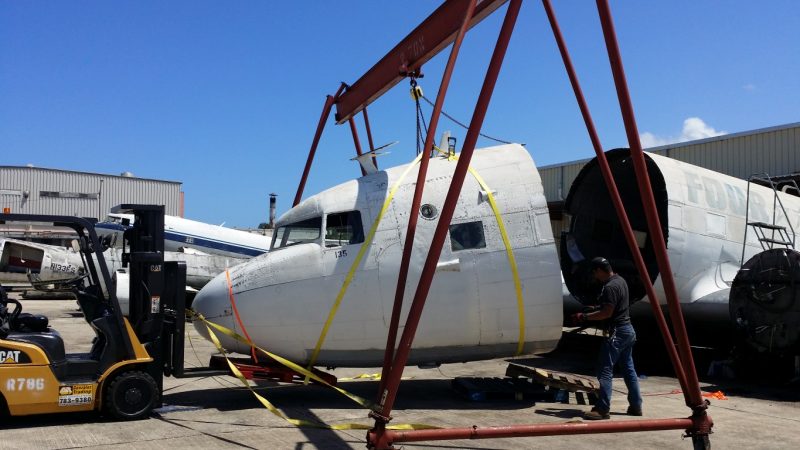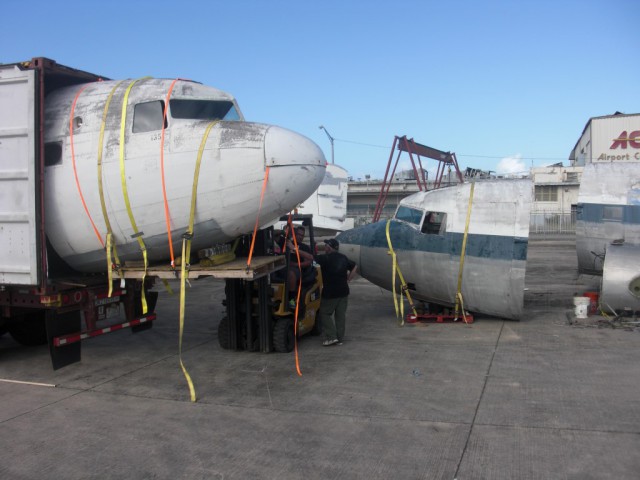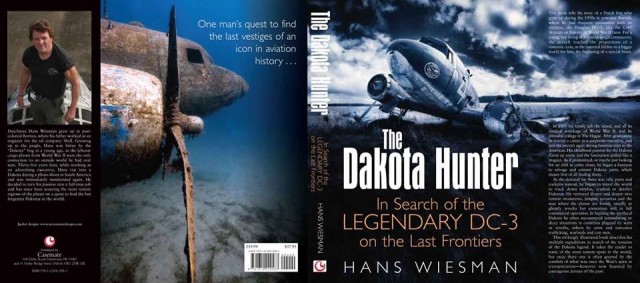Final attempt to save components of these great warbirds from the smelting oven.
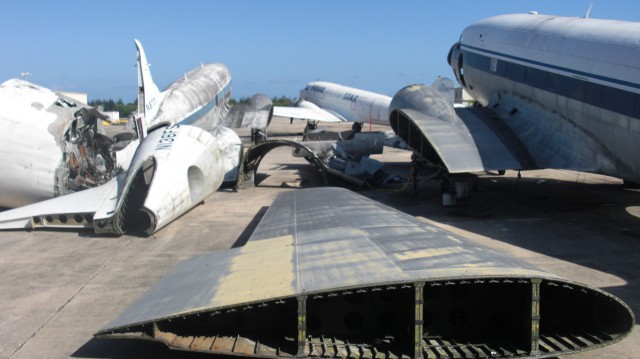
For many decades the DC-3 fleet based on San Juan Int Airport SJU (Puerto Rico) was a thriving business of scheduled and tramp cargo flights all over the Caribbean from Miami to Venezuela and Central America. Back in 1986, I was director of a Pro World Cup Surf event on the French Island of Guadeloupe. The 120 participating pro surfers flew in from the Dominican Republic by regular airline, but their bulky surfboards did not make it on that flight. To avoid delays, I called in the help of a SJU DC-3 operator and Four Star flew overnight all 250 surfboards to our Island on the Eastern side of the Caribbean. With that “relief” flight of the old Gooney Bird still clearly in my memory, I came back to the island in the year 2000, hoping to find surplus parts for my newly started business Avionart, but they needed all bits and pieces to keep their busy fleets airborne. I visited most operators: FourStar, Tolair, Air BVI and others with a total of well over 12 flying DC-3’s and many derelicts parked out there being cannibalized to keep the others flying.
Now, by mid March 2015, the situation has drastically changed, the DC-3 existence on SJU is all history now, its role has been taken over by yet another ‘cheap” vintage aircraft, but half the age (and 10% of the beauty) of the DC-3. It is the Short C-23 Sherpa, aka Boxcar or Flying Winnebago. For years operated by USAF, these ugly but practical turbo props have same payload of 7500 lbs. but surely more modern in lay out and maintenance. Allegedly, mismanagement also played a part; true if not but by 2010 all SJU based DC-3 fleets were grounded.
Of the final 7 DC-3’s that were in SJU, only 2 remained in airworthy condition. One of them (N-138FS aka Snoopy) has been sold in USA and flown out, while one more will soon follow (N131FS)) to Florida, but for 5 other ex C-47’s that have “survived” since the demise of the last operator Four Star in 2010, there is no hope anymore, except for 2 cockpits.
The scrapper always has patience and surely will show up soon for a dreadful end for 3 of the 5 ex WWII veterans that will all burn in hell, in the shape of the smelting oven of the recycling plant. Cast as aluminum ingots, they are soon on their way to the soda can factory. The Old warriors serve soon as a tray of Coca Cola drinks!
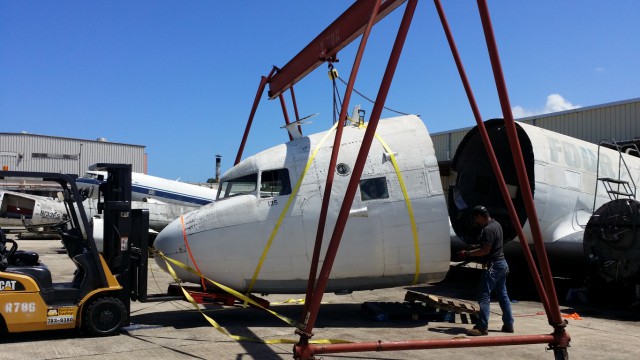
Many people have asked me: How can such nightmare scenario be avoided? The situation is very complex, the aircraft are not in Europe or USA, so transport is awkward and expensive for museums and collectors. The current owners are SURELY not the executioners, they have tried everything to find prospects/buyers over the past 5 years. But with the parking fees no longer paid since the operators went defunct, the airport authority’s patience has come to an end, they are not running a museum so they want to rid the a/c for making way for new business, that is the reality of life.
But there are out there 5 aircraft built in (one maybe just after) WWII that are considered as heritage of American Aviation History. Once the pride of the USAAF, the C-47 paratrooper/ cargo transport was mentioned by Gen. D. Eisenhower in his memories as one of the key factors that won the war for the Allied Forces, the plane that the Germans and Japanese missed so dearly in such numbers with that payload, reliability and ruggedness.
Here we enter in a bizarre gridlock of war relic museum pieces that are to be trashed soon, since there is no museum or private collector yet to be found in the world that can/will afford the transport from there. Many museums that want a C-47 on display simply wait for an occasion that one day an airframe will pop up from an airfield as a abandoned derelict in their state with low transport costs and gifted by the owner/airport. The overseas transport poses a big hurdle, but there was one American collector and friend of mine, Mark Bruce from Massachusetts who accepted that challenge. We made a deal to salvage at least 2 of the DC-3 cockpits from the shredder. That was the best we could do and was affordable with one 45 feet shipping container to be shipped to Boston. The labor factor was only to be kept within budget limits if we did the most part of the separation job with our own hands and tools. With good initial help form the local DC-3 wizard JuanAntonio Vega, Mark started the job and I flew in on Monday 16 March 2015 to join. Next day, time for some serious cutting into precious metal, the aluminum skins of 70 year old warbirds. With relatively simple tools, one small forklift truck and a primitive hand driven hoist, we started with the 2 of us the mission “Save the souls of the Caribbean DC-3’s”. A couple of most memorable days followed.
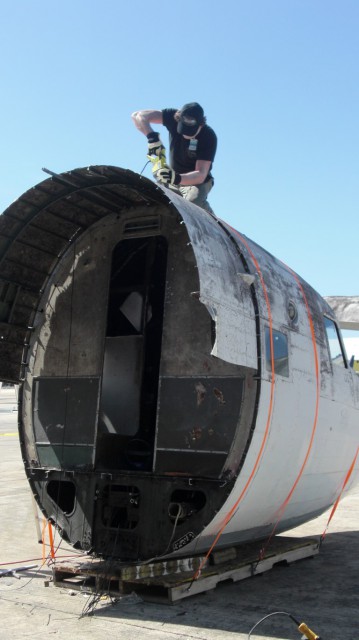
The cutting job was done with mid-sized electric disc grinder and an electric reciprocating saw. Both can handle the aluminum skin, stringers and ribs, as I had learnt on previous cutting jobs of DC-3 cockpits on my earlier salvage expeditions to Bolivia, Thailand, Florida and Madagascar. The snag came with the use of the only available hoist that turned out being too low to lift the cockpit as it comes loose from the fuselage. That front section, sawn off in a full cross section circle, weighs some 500-600 kilos and is a piece of hefty metal that you simply cannot drop from its high up position at some 8 feet above the ground. So, a hoist is needed to quietly lower the cockpit once separated from the airframe. With the crane too low, we first needed to lower the total airframe by “bringing her on her knees”, i.e. folding the landing gear to a retracted (in flight) position.
The forklift truck arrived, lifted the airframe at the engine nacelle and after having removed the big balloon tires & wheels, the next step was the folding of the undercarriage subframe. That seemed easy but ended in a nasty effort in the smothering heat of the Caribbean midday, standing inside the wheel bay and wondering what we did wrong. Locking pins were removed, but it turned out that there was still hydraulic pressure on the lines to the actuators that pull the wheels in and out.
With the efforts made, we were not in here for the money, but trying to save some “Warbird Soul” for posterity and I’ll try to help with all similar endeavors, as now also a great initiative undertaken by David Petters from UK who tries via public funding to bring a British C-47/ Dakota back to flying status under the name “RAF Transport Command Memorial”.
In a final effort on the third day, we had to find a way to get the 2 separated cockpits inside the shipping container that had arrived on a lorry frame of 5 feet height.
Again, the hoist could not be used with this hurdle, so the forklift had to do the job. It turned out that the forklift’s forks were way too short for handling the large cockpit, mounted on a small wooden standard size pallet. It was a job of improvisation and inventiveness to work out a solution with primitive means under a spring break sun with 90 degrees F.
We ended with the salvaging of 2 cockpits only, saved from a fleet of 5 neglected DC-3 airframes, that are now left there on SJU. One airframe was already cut in large sections for disposal, it was the unlucky DC-3 N-136FS that suffered from a cockpit fire in Apr.2009 and was written off. 4 more airframes, left over derelicts from the Four-Star fleet, are parked in that “corrosion corner” where we worked so hard.
On the last day, as the truck with the container drove away from the platform to the harbor, in the mellow yellow light of the last sun rays, we stood there, watching in awe the derelict airframes, in all their final “Beauty of Decay” that was also their agony. It was the end of an era for the last of the Caribbean DC-3s.
But in other remote parts of the globe, the DC-3 still survives in operations where the savanna of jungle airstrips are not yet graded/asphalted. It is there that the Old Warrior’s big balloon tires, low approach speed and taildragger configuration come superbly to avail. This is the final domain of the DC-3 where no turboprop rival as the C-23 Sherpa could ever land with its small wheels and high landing speed.
If interested to read more of the worldwide DC-3 survival, read my book the Dakota Hunter with reports of my 20+ expeditions made to the remote places where the C-47/ DC-3 still thrives. 320 pages of fascinating and adventurous stories and 250 never published photos as visual evidence of the slogan ‘The Dakota flies in low & slow, where no Jet/ Turbo plane , Truck or Boat can go”.
Visit www.dc3-dakotahunter.com for previews and direct ordering of my book at Amazon, Barnes & Noble or the autographed version directly via my site.
